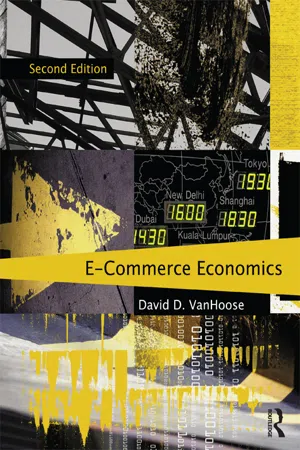Economics
E-money
E-money refers to electronic money, which is a digital alternative to physical cash. It is typically stored and transacted electronically, often through mobile devices or online platforms. E-money provides a convenient and efficient way to make payments and conduct financial transactions without the need for physical currency.
Written by Perlego with AI-assistance
Related key terms
3 Key excerpts on "E-money"
- eBook - ePub
- Stephen Millard, Andrew Haldane, Victoria Saporta(Authors)
- 2008(Publication Date)
- Routledge(Publisher)
et al. (1999), King (1999), Kobrin (1997), Krozner (2003) and Palley (2002). Schmitz (2006a) takes a critical view of the theoretical coherence of these models, arguing that they collapse to either a Walrasian economy, or variants of a commodity standard, or the current monetary system based on central bank money.2 Electronic money is defined in the E-money Directive (2000/46/EC) Article 1 (3)(b) as monetary value as represented by a claim on the issuer which is: (i) stored on an electronic device; (ii) issued on receipt of funds of an amount not less in value than the monetary value issued; (iii) accepted as a means of payment by undertakings other than the issuer.3 According to the advocates of the parallel use of multiple units of account the various issuers of electronic money units of account would compete in three areas: (i) the management of the electronic payments system (i.e. marketing the system to a large number of attractive trading partners, non-pecuniary benefits of participation, reliability and security of the technological and organisational infrastructure, liability for costs in cases of unauthorised payments, loss or fraud), (ii) the financial performance of the reserves backing the systems (i.e. rate of return, volatility etc.), and (iii) the choice of regulatory regime, if such choice is indeed legally possible. The relative performance of reserve assets would then translate into the relative purchasing powers of alternative units of account.4 See Menger (1909), Krüger (1999), Schmitz (2002b) and Selgin and White (2002).5 Another potential direction of research would address the following question: will institutional change in the payments system reduce the marginal costs of a socially concerted adoption of a new generally accepted medium of exchange and a new unit of account? This question is, however, beyond the scope of this chapter.6 - eBook - ePub
- David VanHoose(Author)
- 2011(Publication Date)
- Routledge(Publisher)
3. What are the prospects that digital cash will become commonplace? Some security problems of digital cash, such as counterfeiting and outright theft, are high-tech versions of security concerns people already experience when they use physical currency and coins. Unlike physical money, however, digital cash potentially can be infected by computer viruses, and hardware breakdowns or power failures could hinder or halt digital-cash transactions. Because means of payment are subject to network externalities smart cards and digital cash face a chicken-or-egg problem: Retailers will not desire to adopt these means of payment unless many consumers wish to use them, while consumers are less likely to use smart cards or digital cash unless a large number of retailers accept them.Monetary Policy With Bank-Issued Digital Money
Macroeconomics: The study of a country’s aggregate economic activity.The amount of money in circulation—whether physical or digital—influences the overall purchasing power available to individuals and businesses. For this reason, economists who specialize in macroeconomics, the study of a nation’s total economic activity, focus considerable attention on how central bank policies affect the quantity of money.Money, Depository Institution Reserves, And Deposit Expansion
Transactions deposits: Checkable and debitable deposits at depository institutions.In Chapter 13 , you learned that depository financial institutions issue transactions deposits - eBook - ePub
Money Talks
Explaining How Money Really Works
- Nina Bandelj, Frederick Wherry, Viviana Zelizer(Authors)
- 2017(Publication Date)
- Princeton University Press(Publisher)
In recent years, the surge of new currencies and payment systems has transformed how we use money and how we think about it. Along with cash, credit cards, debit cards, and checks, we can now pay with Square, Google Wallet, Apple Pay, Venmo, as well as with a multiplying set of cryptocurrencies, most notably Bitcoin. Or consider how m-pesa, the mobile phone–based money transfer service, has opened up a crucial new form of payment for people in developing economies. And around the world, emerging local currency communities, barter arrangements, and other peer economies further broaden forms of exchange and payment. Meanwhile, leading economist Kenneth Rogoff in his The Curse of Cash (2016) advocates doing away with paper money. Bringing together a set of scholars from seven disciplines—namely, economics, anthropology, communication, sociology, political science, philosophy, and law— Money Talks represents a pioneering effort to document the multiple advances in monetary analysis and the changes in monetary forms. As they draw from a dazzling panoply of theories and empirical cases, the chapters illuminate money’s past, present, and future. Along the way, our authors grapple with perennial questions but also confront novel dilemmas about money’s constitution, its effects, and how we account for it. The chapters explore the vagaries of monetary practices. What explains the multiple ways in which we use, give, or save money? Are the monies we exchange in our private transactions fundamentally different than those used to trade in financial and corporate markets? Under what conditions, to what extent, and how does the expansion of monetary exchanges transform the prevailing quality of social life? Given the availability of money, how do people incorporate it into transactions that are not explicitly for market exchange? They also tackle macro-level issues involving the creation of money
Learn about this page
Index pages curate the most relevant extracts from our library of academic textbooks. They’ve been created using an in-house natural language model (NLM), each adding context and meaning to key research topics.


